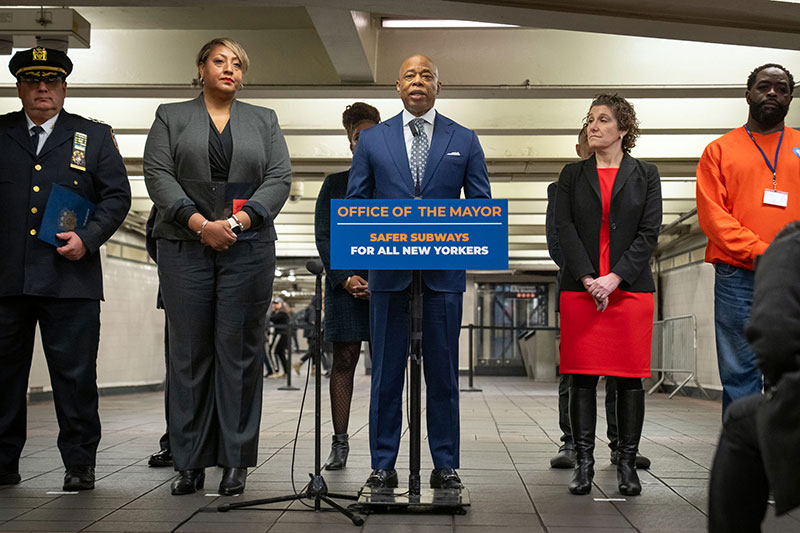Mayor Adams today announced a major milestone in the city’s Partnership Assistance for Transit Homelessness (PATH) program, a key initiative under the Adams administration’s “Mental Health Week.” Since its launch in August 2024, PATH has conducted over 11,000 engagements with unhoused New Yorkers, providing shelter, meals, and medical assistance over 3,000 times. Additionally, the New York City Police Department (NYPD) has issued 290 summonses and removed 911 individuals from the subway system for various violations.
PATH is a collaborative effort between the New York City Department of Homeless Services (DHS), NYC Health + Hospitals, and the NYPD Transit Bureau. The program pairs DHS nurses and outreach staff with NYPD transit police to engage with unsheltered individuals overnight in Manhattan subway stations. The goal is to connect those in need with shelter and care, particularly those suffering from severe mental illness. Mayor Adams emphasized that this program is a vital part of the city’s efforts to address homelessness.
Mental Health Week and Mayor Adams’ Commitment
The Adams administration is observing “Mental Health Week,” showcasing citywide initiatives aimed at addressing serious mental health issues and expanding resources to underserved communities. This aligns with Mayor Adams’ 2025 State of the City commitment to make New York City the best place to live and raise a family.
“Keeping New Yorkers safe is our top priority, especially in the subways,” said Mayor Adams. “With PATH and our Subway Safety Plan, we have already connected over 8,400 New Yorkers to shelter, with more than 860 placed in permanent, affordable housing. We are delivering on our mission to make New York City safer and more affordable.”
Subway Safety Plan and Co-Response Model
PATH builds upon the Subway Safety Plan launched in February 2022, which has connected thousands to shelter. The program employs a “co-response” model where police officers trained in crisis de-escalation work alongside clinical professionals to engage with unhoused individuals. This approach ensures both public safety and effective mental health support. Mayor Adams has highlighted the importance of this approach in achieving safer subway conditions.
Since the plan’s implementation:
- 8,400 New Yorkers have been connected to shelter.
- 860+ individuals have transitioned into permanent housing.
- Crime in the subway system has decreased by 27.9 percent year to date.
Investments in Mental Health and Homelessness Solutions
Mayor Adams has spearheaded a $650 million investment in addressing homelessness and severe mental illness, including:
- Expanding mobile treatment teams.
- Increasing access to clubhouse services for mental health support.
- Launching the “Bridge to Home” initiative to provide transitional housing for those discharged from hospitals.
- Expanding street outreach teams and Safe Haven beds.
Additionally, legislative efforts like the Supportive Interventions Act seek to reform state laws, ensuring individuals with severe mental illness receive necessary care before crises escalate.severe mental illness receive necessary care before crises escalate.
With these continued efforts, New York City is making significant progress in addressing homelessness, improving mental health services, and enhancing subway safety.
Frequently Asked Questions –
What is the PATH program?
PATH (Partnership Assistance for Transit Homelessness) is a collaborative initiative connecting unhoused New Yorkers in the subway system to shelter, medical care, and social services.
How many people has PATH helped so far?
Since August 2024, PATH teams have had over 11,000 engagements and provided direct services more than 3,000 times.
How does the Subway Safety Plan work?
The Subway Safety Plan includes a combination of increased policing, mental health support, and outreach efforts to ensure safer public transportation and assist unhoused individuals in finding shelter.
What has been done to reduce subway crime?
The Adams administration deployed 1,200 additional officers in 2022, later reinforcing the effort with 1,000 more officers daily in 2023. As a result, subway crime has dropped by 27.9% year to date.
How is the city addressing severe mental illness?
The city is investing $650 million into mobile treatment teams, transitional housing, and legislative reforms to ensure those with severe mental illness receive proper care before reaching crisis situations.











Leave a Reply